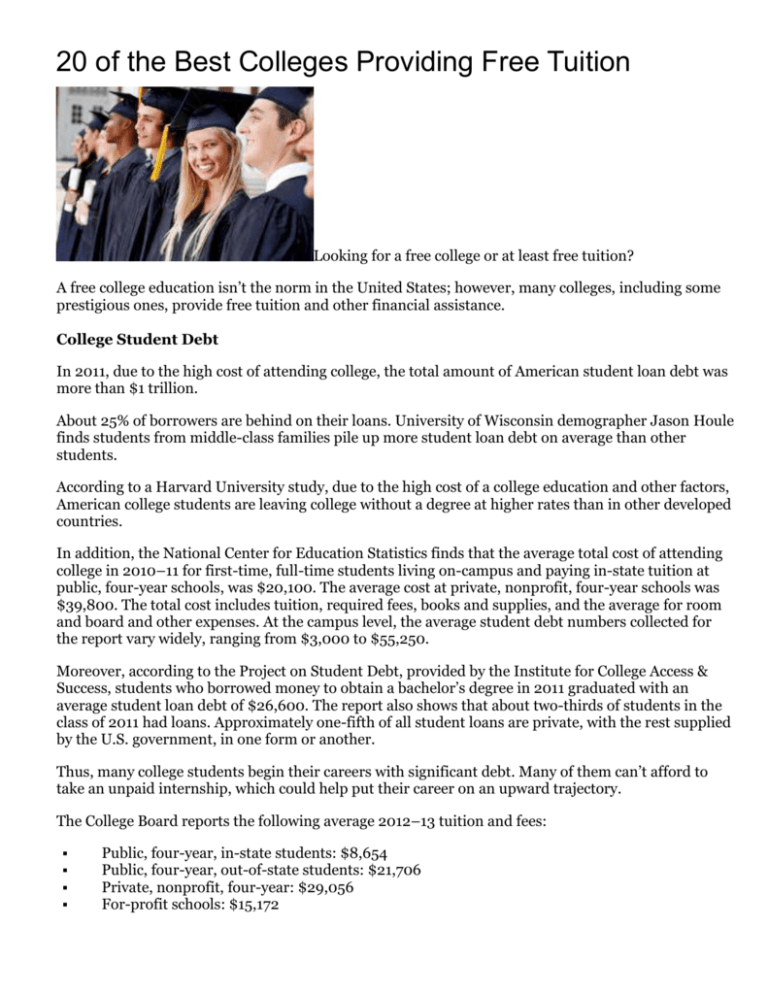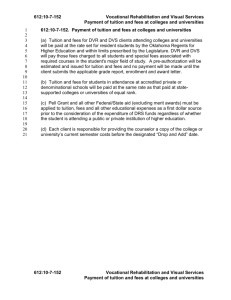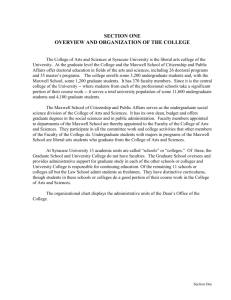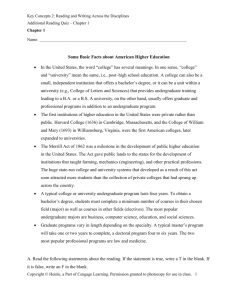20 of the Best Colleges Providing Free Tuition
advertisement

20 of the Best Colleges Providing Free Tuition Looking for a free college or at least free tuition? A free college education isn’t the norm in the United States; however, many colleges, including some prestigious ones, provide free tuition and other financial assistance. College Student Debt In 2011, due to the high cost of attending college, the total amount of American student loan debt was more than $1 trillion. About 25% of borrowers are behind on their loans. University of Wisconsin demographer Jason Houle finds students from middle-class families pile up more student loan debt on average than other students. According to a Harvard University study, due to the high cost of a college education and other factors, American college students are leaving college without a degree at higher rates than in other developed countries. In addition, the National Center for Education Statistics finds that the average total cost of attending college in 2010–11 for first-time, full-time students living on-campus and paying in-state tuition at public, four-year schools, was $20,100. The average cost at private, nonprofit, four-year schools was $39,800. The total cost includes tuition, required fees, books and supplies, and the average for room and board and other expenses. At the campus level, the average student debt numbers collected for the report vary widely, ranging from $3,000 to $55,250. Moreover, according to the Project on Student Debt, provided by the Institute for College Access & Success, students who borrowed money to obtain a bachelor’s degree in 2011 graduated with an average student loan debt of $26,600. The report also shows that about two-thirds of students in the class of 2011 had loans. Approximately one-fifth of all student loans are private, with the rest supplied by the U.S. government, in one form or another. Thus, many college students begin their careers with significant debt. Many of them can’t afford to take an unpaid internship, which could help put their career on an upward trajectory. The College Board reports the following average 2012–13 tuition and fees: Public, four-year, in-state students: $8,654 Public, four-year, out-of-state students: $21,706 Private, nonprofit, four-year: $29,056 For-profit schools: $15,172 Public schools are often recognized as less expensive than private colleges; however, many students at private schools don’t pay the full cost of their education. For example, at Yale, in 2011, the average financial aid for the 57% of students who qualified was $38,900. Check out the Ivy League Schools The Ivy League schools are some of the most expensive schools in the nation. On the other hand, most Ivy League schools provide free tuition and other financial assistance for students from families with an income below a specific threshold, such as $60,000. All of the Ivy League schools have a “noloans” policy; they provide grants instead of loans. Top colleges have become more generous with grants. A major reason for this is that they don’t want to pass up on exceptional students who may go on to have notable careers. College Selection Guidelines We selected the best colleges providing free tuition, based on financial aid packages, quality of degree programs, types of courses offered, faculty prestige, rankings, awards, and overall school reputation. We provide two lists: Colleges offering free tuition to most students, and colleges offering free college tuition to students from families with an income below a specific income ceiling. Best Colleges Providing Free Tuition Based on Family Income (Note: Many top schools offering free tuition to families with an income below a specific ceiling could be in this list. University of North Carolina at Chapel Hill and Texas A&M University, in particular, have been included on account of their relatively high acceptance rates.) #1 Harvard University Harvard University, a private, Ivy League research university, is located in Cambridge, Massachusetts. The university’s history, wealth, and influence makes it one of the world’s most prestigious universities. The Harvard University Library is the nation’s largest academic library and one of the largest in the world. Harvard University is ranked #1 in the 2013 edition of the Best Colleges in National Universities by U.S. News & World Report, and #6 by Forbes. Harvard was also ranked #3 in 2012 in the QS World University Rankings. The university provides a variety of undergraduate and graduate degree programs. The university has about 20,000 students and a 7-to-1 student/faculty ratio. Harvard has a 6% acceptance rate and a 97% first-year, full-time student retention rate. SAT test scores (25th/75th percentile) are as follows: Critical reading: 690/790; math: 700/800; and writing: 690/790. Admission to Harvard University is need-blind; however, financial aid at Harvard University is entirely need-based. The University is devoted to meeting the demonstrated need of all students. Due to the Harvard Financial Aid initiative, parents with an income below $60,000 are not expected to contribute to college costs. Home equity and retirement accounts are not considered resources in determining family contribution. Financial aid packages do not include loans. Families with higher incomes dealing with unusual financial challenges may also qualify for needbased scholarship assistance; however, those with significant assets at all income levels are asked to contribute proportionally more. Tuition and fees amounts to $40,867, while room and board is $13,630. Beginning with the Class of 2016, families with incomes between $65,000 and $150,000 will contribute from 0% to 10% of income, and those with incomes above $150,000 will be asked to pay proportionately more than 10%, based on their individual circumstances. About 70% of students receive some type of financial aid and more than 60% receive need-based scholarships. Students are asked to contribute to cover the cost of their education through term-time and summer work. #2 Yale University Yale University, a private, Ivy League research university, is located in New Haven, Connecticut. a member of the Association of American Universities, Yale has the top-ranked law school in the country, as well as highly ranked school of medicine, management, nursing, and art. Yale University has about 5,300 undergraduate and 6,100 graduate and professional students, with a 5-to-1 student/faculty ratio. Also, the university has over 450 active organizations on campus. Besides thoroughly studying their major field, students are expected to explore three important areas of knowledge: the social sciences, the humanities and arts, and the natural sciences. Students live in one of the residential colleges during their time at Yale. The university is well known for its secret societies. The faculty is known for its special devotion to undergraduate teaching. Many of the university’s most distinguished professors teach introductory courses and advanced seminars to undergraduate students. Yale University is ranked #3 in the 2013 edition of the Best Colleges in national universities by U.S. News & World Report. It is ranked #7 in the 2012 QS World University Rankings and #10 in the Times Higher Education World University Rankings. Yale University has a 7.7% acceptance rate and a 98% first-year student retention rate. SAT test scores (25th/75th percentile) are as follows: Critical reading: 700/800; math: 710/790; and writing: 710/800. The total cost of attending Yale is about $58,600 per year, which includes tuition, room and board, books, and personal expenses. Families with a total gross income of less than $65,000 are not expected to make a contribution for their child’s education. Yale University meets 100% of demonstrated financial need. The expected annual parent contribution is $10,000; however, more than 10% of Yale University undergraduate families are expected to pay nothing for the education. The estimated family contribution includes a contribution out of the student’s assets, if appropriate, along with income from summer earnings, which is standard for most undergraduate students. #3 Massachusetts Institute of Technology Massachusetts Institute of Technology (MIT), a private, research university located in Cambridge, Massachusetts, has five schools and one college. MIT has almost 10,900 students and an 8-to-1 student/faculty ratio. The school has a strong emphasis on scientific, technological, and engineering education and research. MIT also has a strong entrepreneurial culture. MIT is part of the Association of American Universities. MIT is included among the top 10 in many overall rankings of universities. The school’s strongest showings, besides in engineering, are in the fields of business, natural sciences, linguistics, economics, and mathematics. The university is ranked #6 in the 2013 edition of the Best Colleges in National Universities by U.S. News & World Report, and #1 in 2012 by QS World University Rankings. MIT has an acceptance rate of 9.7% and an average freshman retention rate of 97.5%. SAT test scores (25th/75th percentile) are as follows: Critical reading: 670/770; math: 740/800; and writing: 680/770. The institute provides free tuition with scholarships and grants for students from families with earnings of $75,000 or less. Twenty-nine percent of MIT undergraduates come from families with an income of $75,000 or less. All students receiving aid are expected to pay for a portion of their need via a loan, part-time job, or both. Sixty-two percent of undergraduates work during the term, either on campus or under the Federal Work-Study Program. In 2011–2012, students from families earning $75,000 or less are expected to contribute $4,400; the rest of the students contribute $6,0000. Tuition and fees amount to $42,050, while room and board is $12,188. Seventy-four percent of undergraduates receive a need-based or merit-based scholarship, 61% of which receive a need-based MIT scholarship with an average award of $32,917. Forty-one percent of undergraduates have student debt after graduation; the average debt at graduation is $20,800. #4 Columbia University Columbia University, located in New York City, is a private, Ivy League research university. The university has three undergraduate schools: Columbia College, the School of General Studies, and The Fu Foundation School of Engineering. Columbia also has a number of graduate and professional schools. The university offers more than 100 majors and concentrations. Columbia University is a founding member of the Association of American Universities. The student population consists of about 26,000 students, including a little more than 8,100 undergraduates. Over 90% of students live in on-campus housing. The school has 6-to-1 student/faculty ratio. Columbia University operates seven Columbia Global Centers overseas, in Amman, Bejing, Istanbul, Mumbai, Nairobi, Paris, and Santiago. Columbia University is ranked #4 in the 2013 edition of the Best Colleges in National Universities by U.S. News & World Report, and #8 by Forbes. Columbia University is tied for first in the first tier of the nation’s top research universities list by the Center for Measuring University Performance. Columbia University accepts about 10% of applicants. SAT test scores (25th/75th percentile) are as follows: Critical reading: 690/780; math: 700/790; and writing 690/780. Columbia University has a 95% first-year, full-time student retention rate. Parents with calculated incomes of less than $60,000 and with typical assets are not expected to contribute any income or assets to tuition, room and board, or mandatory fees. No student qualifying for Columbia financial aid is expected to take out loans as part of his or her financial package. Families with calculated incomes between $60,000 and $100,000 have a reduction in their parent contributions. The university has no official income ceiling for financial aid eligibility. It reports that many families with calculated incomes over $100,00 receive financial aid packages. For students participating in the study abroad program, community service opportunities, internships, and research, Columbia University provides additional funding and exemptions from academic year and summer work expectations. #5 Stanford University Stanford University, a private, research university located in Stanford, California, offers undergraduate and graduate degree program in a variety of subjects. Stanford has seven schools: earth sciences, humanities and sciences, business, medicine, law, engineering, and education. The schools of engineering, humanities and sciences, and earth sciences provide undergraduate and graduate programs, whereas the schools of medicine, law, and education and the graduate school of business only provide graduate programs. Stanford University is a founding member of the Association of American Universities. The university has over 15,300 students. It reports that it values close interaction between undergraduate students and faculty members. The university also strongly supports student participation in research. Stanford has an entrepreneurial character. The university emphasizes multidisciplinary approaches to teaching and research. Also, Stanford University provides the Bing Overseas Studies Program. In 2011, Stanford was ranked #1 in the world in both humanities and social sciences by The Times of Higher Education World Rankings. That same year, the university was also ranked #2 best research university by THES, and #2 in the world by the Academic Ranking of World Universities. In 2012, it was ranked #15 by QS World University Rankings, while it is also ranked #6 in the 2013 edition of the Best Colleges in National Universities by U.S. News & World Report, and #3 by Forbes. Stanford University has a 7% admission rate and a 98% first-year student retention rate. SAT scores (25th/75th percentile) are as follows: Critical reading: 670/770; math: 690/780; and writing: 680/780. Tuition and fees amount to $41,787, while room and board is $12,721. Parents with an income below $60,000 and typical assets for this income range are not expected to make any financial contribution to their child’s education. For parents with an income below $100,000 and typical assets for this income range, the expected parent contribution is low enough to make sure all tuition charges are covered with need-based scholarships, state and federal grants, and/or outside scholarship funds. Families with incomes at higher levels, usually up to $200,000, may also qualify for assistance, especially if more than one family member is attending college. Students receiving a financial aid package are expected to contribute to paying for the cost of their education. Most students will contribute at least $5,000 from prior earnings, especially summer earnings, and $2,800 from part-time employment during the academic year. Students are also expected to contribute 5% per year of their savings and investments, if they have any. Students can reduce or eliminate their expected contribution from student earnings by acquiring outside scholarships. #6 Duke University Duke University, a private research university located in Durham, North Carolina, is a global university with student and faculty from numerous countries. The university encourages students to go abroad to study, conduct research, and perform service. Duke University is ranked #8 in the 2013 edition of the Best Colleges in National Universities by U.S. News & World Report, and #24 by Forbes. The university is also ranked #27 in the nation and #35 in the world by the Academic Ranking of World Universities, as well as #26 in the nation by Washington Monthly, and #20 in 2012 by QS World University Rankings. Duke University is a member of the Association of American Universities, and is a part of the “research triangle,” along with UNC Chapel Hill and North Carolina State University. Duke has about 6,800 undergraduates, and 6,000 graduate and professional students, distributed among 10 schools and colleges. The university has a 7-to-1 student/faculty ratio. Graduate programs include the highly ranked Pratt School of Engineering, Fuqua School of Business, School of Medicine, School of Law, School of Nursing, and the Sanford School of Public Policy. Duke University also provides graduate programs through its Divinity School and Nicolas School of the Environment. Duke accepts about 16% of the applicants and has a 97% first-year student retention rate. SAT test scores (25th/75th percentile) are as follows: Critical reading: 650/750; math: 690/780; and writing: 670/770. Domestic families with a total institutionally determined income less than $60,000 and typical assets are not expected to make a contribution to their child’s education. The estimated total cost of attending Duke University for one year is $59,343, which includes tuition, fees, room and board, books, and personal expenses. The average financial aid awarded to the class of 2014 for families with various annual income levels is shown below: $60–79.9K: About $48,000 $80–100K: About $41,000 $100–120K: Approximately $40,000 $120K+: Approximately $19,000 The student portion of the Expected Family Contribution is based on every student’s working during the summer to invest in their education. First-year students are expected to earn $2,100, sophomores, $2,400, juniors, $2,500, and seniors, $2,600. #7 Brown University Brown University, a private, Ivy League research university located in Providence, Rhode Island, consists of the College, Alpert Medical School, the Graduate School, and the School of Engineering. Brown’s international programs are organized via the Watson Institute of International Studies. The Graduate School provides a number of notable programs, including in English and history. The university provides an array of undergraduate and graduate degree programs. Brown is the only major research university in the nation where undergraduates are the architects of their own course of study. It is often considered the most liberal of the Ivy League Schools. Brown has more of an undergraduate focus than other top-ranked universities. Brown University is often recognized for its global reach, numerous campus groups, active community service programs, and many cultural events. The university is a member of the Association of American Universities, and has 8,649 students from all 50 states and over 100 countries. The school has a 9-to-1 student/faculty ratio. Brown University is ranked #15 in the 2013 edition of the Best Colleges in National Universities. In 2012, Brown University was ranked #51 in the Times Higher Education World University Rankings, and #42 in the 2012 QS World University rankings. Brown University has a 9% acceptance rate. SAT test scores (25th/75th percentile) are as follows: Critical reading: 630/740; math: 650/760; and writing: 640/750. The university has a first year 98% retention rate. Families with total parent earnings of less than $60,000 and assets of less than $100,000 are not required to make a financial contribution to their child’s education. Undergraduate students with a total parent income of less than $100,000 do not have a loan component in their award. Tuition is $43,758 per year and the total direct and indirect costs are $58,140. Brown University meets 100% of a student’s full, demonstrated need. Forty-six percent of the class of 2016 received need-based scholarships; the average need-based scholarship is $40,209. The student contribution from summer earnings is a standard contribution required for all students. An academic year work-study/campus employment expectation is part of the federal financial aid program. The following information for the 2012–2013 academic year is based on one student attending Brown University: Family of five, with one junior student with a total income of $87,000 and assets of $161,000, pay $17,400 Family of four, with one sophomore student with a total income of $105,000 and assets of $63,000, pay $20,770 Family of four, with one freshman student with a total income of $53,000 and assets of $127,000, pay $4,790 Family with one freshman student with a total income of $160,000 and assets of $150,000 pay $40,050 #8 Cornell University Cornell University, a private, Ivy League research university located in Ithaca, New York, has seven undergraduate and seven graduate divisions at its main Ithaca campus. The university offers a variety of undergraduate and graduate degree programs. It also administers two satellite medical campuses, one in New York City and one in Education City, Qatar. Cornell is ranked #15 in the 2013 edition of the Best Colleges in National Universities by U.S. News & World Report. It is ranked among the 20 top universities in the world in a variety of rankings. The university is a member of the Association of American Universities. Its research spans a wide array of subjects, ranging from the basic and theoretical to applied research. Cornell University has over 20,900 students and a 9-to-1 student/faculty ratio. The university has students from all 50 states and 122 countries. Cornell has an 18% acceptance rate and a 97% freshman retention rate. SAT test scores (25th/75th percentile) are as follows: Critical reading: 630/730; and math: 670/770. Parents with a combined income of less than $60,000 and assets totaling less than $100,000 pay nothing for their child’s education. Students contribute money from a summer job and a small amount of money from savings. The total estimated cost of attending Cornell University for one year is $59,751, which includes tuition, student activity fees, housing, dining, books and supplies, personal expenses, and travel expenses. The university’s website uses as an example a student with a total family income of $51,000 and less than $100,000 in assets; in this scenario, the parents pay nothing for their child’s education. The student received a total financial aid package of $56,501 per year, consisting of a Cornell Grant and Federal Work Study, including about 10 hours or work per week in a campus job during the academic year. The student is expected to contribute $3,250 for his first year at Cornell University, which includes $750 from his own personal assets of $3,000 dollars and the money—about $2,500—he will earn from a summer job prior to entering Cornell University. Cornell University doesn’t have a standard “income bracket” or ceiling for grant-aid recipients; rather, eligibility is determined on a case-by-case basis. The university doesn’t have a minimum or maximum amount of grant awarded. Income, family size, and assets, as well as the number of children in college, are all factors for calculating the amount a family is required to contribute. #9 Vanderbilt University Vanderbilt University, a private, research university located in Nashville, Tennessee, has about 12,000 students from all 50 states and from more than 90 foreign countries. Vanderbilt has an 8-to-1 student/faculty ratio. Also, due to the university’s emphasis on research, it is a member of the Association of American Universities. The university tends to place well in national rankings. Vanderbilt University is ranked #17 in the 2013 edition of the Best Colleges in National Universities by U.S. News & World Report, and #33 by Forbes. Vanderbilt has the following undergraduate schools and colleges: College of Arts and Science, Peabody College of Education and Human Development, School of Engineering, and Blair School of Music. The university has the following graduate and professional schools: Divinity School, Law School, Graduate School, School of Nursing, School of Medicine, and the Owen Graduate School of Management. It also has six graduate and professional schools. Vanderbilt provides 70 undergraduate majors; students can also create their own majors. The university’s study abroad program is provided in over 25 countries. The university accepts about 16% of applicants. SAT test scores (25th/75th percentile) are as follows: Critical reading: 680/770; math: 700/780; and writing: 670/760. Vanderbilt University has a 95% first-year student retention rate. Tuition and fees per year cost an estimated $42,824. The estimated total cost of attending Vanderbilt University is $60,596 per academic year, which includes tuition, fees, room and board, and books. In 2012–2013, over 60% of undergraduate students received some type of financial assistance from one or more sources. All students with demonstrated financial need receive grant/gift assistance instead of loans. Vanderbilt University meets 100% of a family’s demonstrated financial need. Financial aid awards do not include loans. The median award for families in the income range of $0 to $40,000 is $59,147, and the awards range from $31,748 to $63,940. The average financial aid package for first-year students entering the university in 2012 who received need-based assistance (including Vanderbilt funds) consisted of 97% gift aid and 3% work. Need-based awards to first-year students of 2012/2013 based on family income are shown below: $40–$60K: $57,512 $60–$80K: $53,542 $80–$100K: $49,543 $100–$120K: $45,328 $120–$140K: $39,567 $200K+: $17,061 #10 University of North Carolina at Chapel Hill The University of North Carolina at Chapel Hill (UNC), a public, research university located in Chapel Hill, North Carolina, provides over 70 bachelor’s, over 100 master’s, and 74 doctoral degree programs. All undergraduate students receive a liberal arts education. Undergraduate students have the option to pursue a major within the College of Arts and Sciences or within one of the university’s professionals schools from the time they obtain junior status. University of North Carolina at Chapel Hill is ranked #30 in the 2013 edition of the Best Colleges in National Universities, and #5 top public school, by U.S. News & World Report. Many of the university’s professional schools have received high rankings in publications such as U.S. News & World Report and Forbes magazine. UNC has more than 28,000 students. By law, at least 82% of each freshman class must be from North Carolina. Nearly half of all undergraduates live on campus. The University of North Carolina provides 300 study abroad programs in 70 countries. The university has one of the highest percentage of undergraduates studying abroad of any public institution. University of North Carolina has a 31% acceptance rate. SAT test scores (25th/75th percentile) are as follows: Critical reading: 590/700; math: 610/710; and writing: 590/690. The university has 97% freshman retention rate. The Carolina Covenant promises that youth from low-income families eligible for the program can graduate with a bachelor’s degree with no debt. To be eligible for the Carolina Covenant, students must be enrolled at the school as a full-time undergraduate student, be dependent on a parent whose income is no more than 200% of federal poverty guidelines and not have other resources to pay for college, meet citizen requirements, and meet eligibility standards for federal financial aid programs. Students from any state are considered for the Carolina Covenant. In-state tuition and fees cost $7,694, and out-of-state tuition and fees cost $28,446. Room and board costs $9,734. #11 Texas A&M University Texas A&M University, a public, research university located in College Station, Texas, is the flagship institution of the Texas A&M University System. Texas A&M is involved in a broad range of research with projects funded by agencies, including the National Institutes of Health, the National Aeronautics and Space Administration, the Office of Naval Research, and the National Science Foundation. The university has formal research and exchange agreements with 100 institutions in 40 countries. The university consistently ranks among the top 10 public universities every year in enrollment of National Merit Scholars. Texas A&M University has been ranked #23 among the top public schools by U.S. News & World Report. Texas A&M has about 48,000 students and a 21-to-1 student/faculty ratio. The university has 10 academic colleges and offers over 120 undergraduate and 240 graduate degree programs. The university has highly ranked graduate offerings via its Mays Business School, Dwight Look College of Engineering, and College of Education and Human Development. Texas A&M is one of six United States Senior Military Colleges. Its Corp of Cadets is one of the largest uniformed student bodies outside the service academies. Sixty-two percent of applicants are accepted. SAT test scores (25th/75th percentile) are as follows: Critical reading: 530/650; math: 570/670; and writing: 510/620. The university has a 92% freshman retention rate. The Aggie Assurance helps students with a family income of less than $60,000. All eligible students receive scholarships and grants to cover the cost of tuition. Many of the students eligible for free tuition also receive other scholarships and grants to help cover the cost of required fees, housing, book,s and other educational expenses. The total cost for in-state students is $20,723 per year ($36,113 for out-of-state students).






